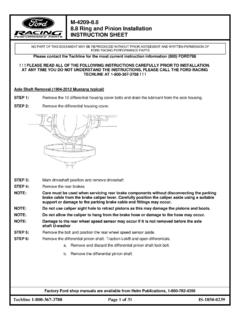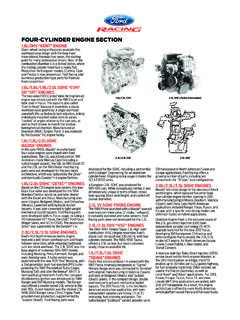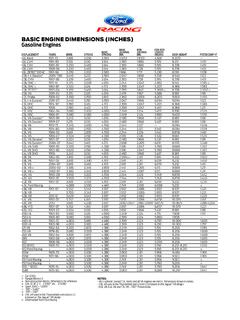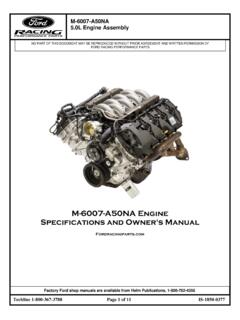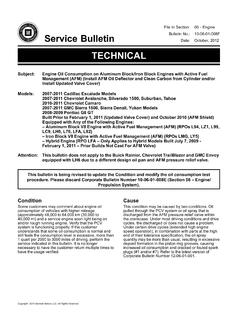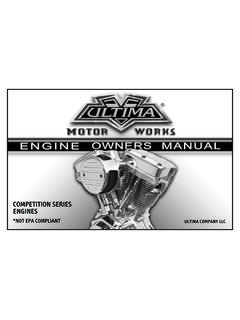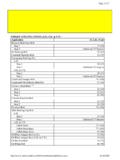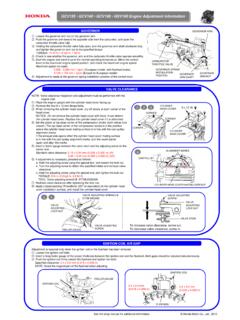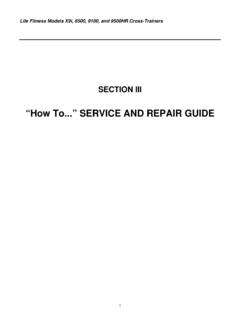Transcription of ValVe lash and lifter Pre-load - Ford Motor Company
1 ValVe lash and lifter Pre-loadValve lash and lifter Pre-load are commonly referred to as setting the valves . This critical assembly process is a key operation for all engine builders and technicians. Setting the valves provides the camshaft lobe profiles to be transferred into ValVe motion. To attain the performance features designed into the camshaft, the lash or Pre-load must be properly vs. Pre-LoadLash ValVe lash by definition is the gap between the rocker arm and the tip of the ValVe stem. The rocker arm may have ground radius or a steel roller, and the ValVe tip is ground perpendicular to the ValVe stem. This gap is usually measured with feeler gauges and is adjusted by threaded nut. The adjuster nut is locked in position with a set screw.
2 Each ValVe is adjusted train systems that have a lash setting must utilize a solid tappet. This tappet can be a solid roller tappet or a solid flat tappet. Solid tappets do not allow any movement within the tappet itself. The system must also provide a means for fine-tuning the lash, in most cases a threaded adjuster and locking Pre-load by definition is the distance the plunger, inside the tappet, is depressed from the fully extended position. This movement takes place inside the tappet itself. Both hydraulic flat and hydraulic roller tappets contain components that meter and retain a small reservoir of oil. This Pre-load correctly positions the plunger into the working range of the tappet body. Total plunger travel is approximately.
3 140".For hydraulic ValVe train systems, the lifter Pre-load can be adjusted by using a threaded adjuster and locking device, by shimming the rocker arm pedestal and by push rod length. Setting Lash and Pre-LoadBoth lash and Pre-load are set when the camshaft is on the base circle. Knowing when the cam is on the base circle is the key to setting the valves correctly. There is one bulletproof way for determining when the lifter is on the base circle and it is displayed on the graph below. A trick for remembering the sequence is to use stands for: INTAKE ( ValVe ) CLOSES (lash) EXHAUST. By looking at the chart, it becomes clear that the exhaust must be on the base circle when the intake ValVe closes.
4 Conversely, for insuring the intake is on the base circle, this condition occurs when the exhaust ValVe opens. This works for every single cam no matter how high the lift or long the summary, always remember For example: Bring cylinder #1 to TDC (FIRING) Rotate engine clockwise until the exhaust lifter (or push rod tip) begins to open Set the lash or Pre-load on the INTAKE ValVe for cylinder #1 Rotate the engine clockwise until the intake ValVe opens and just closes Set the lash or Pre-load on the EXHAUST ValVe for cylinder #1 Repeat for the rest of the engineWhen setting or checking lash and Pre-load , don t be in a hurry; for initial engine builds, put one rocker on at a time. If you are checking lash, do one cylinder at a time and mark each ValVe checked on the corresponding rocker arm with a marker.
5 Intake ValVe closes ( ) Exhaust ValVe opensSet the EXHAUST ValVe Set the INTAKE 0 TDCF iring100200300400500600 CamLobeLiftLobe Lift vs. Crank DegreesIntake ValVe closesSet the EXHAUSTE xhaust valveopensSet the INTAKEE xhaust Lobe LiftIntake Lobe LiftTDC OverlapCrank DegreesExhaust Lobe LiftIntake Lobe Lift
